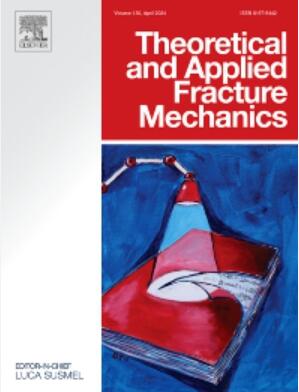Study on the true triaxial compression mechanical behavior of fissured granite and its micro-fracture mechanism based on the grain-based model
IF 5.6
2区 工程技术
Q1 ENGINEERING, MECHANICAL
引用次数: 0
Abstract
Understanding the mechanical properties and rupture mechanism of fissured rocks under true triaxial stress conditions is of great significance in guiding engineering practice and preventing geo-engineering disasters. In this study, the mechanical properties, deformation characteristics, and damage mechanisms of prefabricated fissured granite were investigated by laboratory true triaxial experiments and grain-based model (GBM) simulations. Granite specimens with seven different fissure geometries (rock bridge inclination and length and fissure inclination) were tested in true triaxial compression tests. As a complementary study, the mineral composition and microstructure of granite were modeled using GBM numerical simulations for purpose of analyze the evolution of microfractures. The obtained results indicate that, larger rock bridge inclination, smaller rock bridge length, and larger crack inclination decreased the peak strength (up to 76.31 %), damage threshold, and modulus of elasticity of the specimens. Based on the specific configuration of the fissures, the pattern of damage underwent a transformation. It shifted from tensile shear cracks to a type of mixed tensile-shear cracks where the tensile cracks were predominant, and these cracks fully traversed the rock bridge region. Acoustic emission (AE) analysis shows that the fissured samples exhibit earlier and more intense energy release due to accelerated microcrack formation and propagation, and this effect is more pronounced at larger rock bridge inclinations, smaller rock bridge lengths, and larger rift inclinations. Numerical simulations validate the ability of GBM to capture macroscopic deformation and failure modes, showing strong agreement with the experimental stress-strain response (the peak stress deviation < 4.04 %). The microcrack evolution analysis emphasizes that cracks mainly start at the fissure tip and that the rock bridge geometry has a key influence on the propagation trajectory. In addition, the intermediate principal stress () enhances the peak strength but weakens as the effect of cracking increases, especially at larger rock bridge inclinations or smaller fissure angles. This exploration offers new insights of view on the micromechanical fracture mechanism of cleft granite under complex stress states, and provides theoretical and practical guidance for the stability assessment of deep underground engineering.
基于颗粒模型的裂隙花岗岩真三轴压缩力学行为及微断裂机理研究
了解裂隙岩在真三轴应力条件下的力学特性和破裂机理,对指导工程实践和预防地质工程灾害具有重要意义。采用真三轴试验和颗粒模型(GBM)模拟方法,对预制裂隙花岗岩的力学性能、变形特征及损伤机理进行了研究。在真三轴压缩试验中,对具有7种不同裂缝几何形状(岩桥倾角、长度和裂缝倾角)的花岗岩试件进行了测试。作为补充研究,利用GBM数值模拟方法模拟花岗岩的矿物组成和微观结构,分析微裂缝的演化过程。结果表明:岩桥倾角越大、岩桥长度越小、裂缝倾角越大,试件的峰值强度、损伤阈值和弹性模量降低幅度达76.31%;根据裂缝的具体形态,损伤模式发生了转变。由拉剪裂缝转变为以拉剪裂缝为主的拉剪混合裂缝类型,且这些裂缝完全穿越岩桥区域。声发射(AE)分析表明,由于微裂纹的形成和扩展加速,裂隙试样的能量释放更早、更强烈,且这种影响在较大的岩桥倾角、较小的岩桥长度和较大的裂缝倾角时更为明显。数值模拟验证了GBM捕获宏观变形和破坏模式的能力,与实验应力-应变响应(峰值应力偏差<;4.04%)。微裂纹演化分析强调裂纹主要从裂纹尖端开始,岩桥几何形状对裂纹扩展轨迹有关键影响。中间主应力(σ2)增强了岩石的峰值强度,但随着裂缝作用的增加而减弱,特别是在较大的岩桥倾角和较小的裂缝角时。这一探索为认识裂隙花岗岩在复杂应力状态下的微力学断裂机制提供了新的视角,为深部地下工程稳定性评价提供了理论和实践指导。
本文章由计算机程序翻译,如有差异,请以英文原文为准。
求助全文
约1分钟内获得全文
求助全文
来源期刊

Theoretical and Applied Fracture Mechanics
工程技术-工程:机械
CiteScore
8.40
自引率
18.90%
发文量
435
审稿时长
37 days
期刊介绍:
Theoretical and Applied Fracture Mechanics'' aims & scopes have been re-designed to cover both the theoretical, applied, and numerical aspects associated with those cracking related phenomena taking place, at a micro-, meso-, and macroscopic level, in materials/components/structures of any kind.
The journal aims to cover the cracking/mechanical behaviour of materials/components/structures in those situations involving both time-independent and time-dependent system of external forces/moments (such as, for instance, quasi-static, impulsive, impact, blasting, creep, contact, and fatigue loading). Since, under the above circumstances, the mechanical behaviour of cracked materials/components/structures is also affected by the environmental conditions, the journal would consider also those theoretical/experimental research works investigating the effect of external variables such as, for instance, the effect of corrosive environments as well as of high/low-temperature.
 求助内容:
求助内容: 应助结果提醒方式:
应助结果提醒方式:


